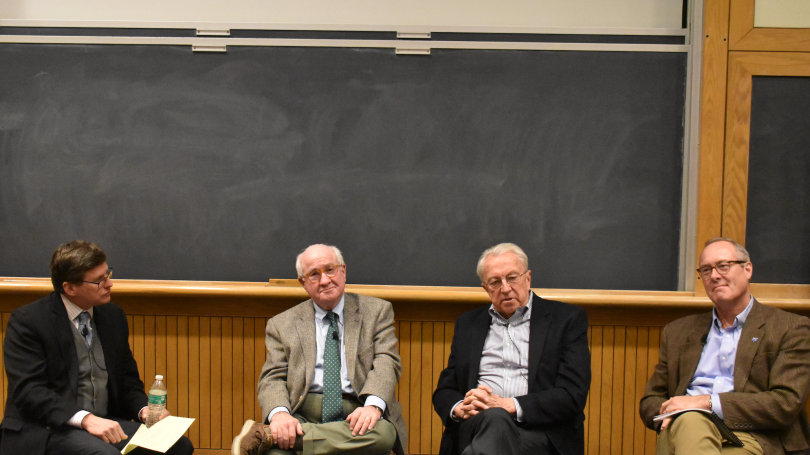
- Public Policy
- Leadership
- Funding
- News & Events
- About the Center
Back to Top Nav
Back to Top Nav
Back to Top Nav
Back to Top Nav
On January 22, 2020, in a discussion moderated by Senior Lecturer and Policy Fellow Charles Wheelan, panelists Ned Helms, Tom Rath ‘67, and Andrew Smith sought to provide students and visitors at the Rockefeller Center with a preview to the 2020 New Hampshire presidential primary, set for February 11. As seasoned experts in the local and national political sphere, Helms, Rath, and Smith each used their diverse experiences in campaign work and analysis to draw connections to past elections, describe modern-day campaign challenges, and explain why New Hampshire has become such a critical state in our national election cycle.
As someone whose first exposure to the New Hampshire primary was as a Dartmouth student working on Nelson A. Rockefeller’s campaign in 1964, Rath has since served on the campaigns of several Republican candidates, including Robert Dole, George W. Bush, and Mitt Romney. Despite the advancements of technology, broadcasting, and social media that have reshaped the structure of the modern-day campaign, however, Rath notes that in New Hampshire, candidates still honor the tradition of “coming up here to meet people.” Rath explained that “The essential validation for the New Hampshire primary, [is] that it brings the race down to very human dimensions.” “[New Hampshire] doesn’t decide [the primary process],” Rath emphasized; rather, “the coverage that New Hampshire receives because of when we are helps other people in other places see candidates in… humane situations as opposed to just their television advertisements or the debate stage.”
What also makes this state special, Rath explains, is that “you can start here, even more than in Iowa, with a lot less money and a lot less organization.” Helms, who worked on Democrat Gary Hart’s campaign in 1988, wholeheartedly agreed, noting Hart’s unexpected success in New Hampshire was a result of his “tremendous field organization.” In the Upper Valley today, this organization has taken shape through the work of young adults, such as students at Dartmouth, who seek to make a difference by joining a campaign. “One of the most exciting things to see,” said Helms, are the “young people” who “come from around the country to work on the New Hampshire primary.” This mobilization will be critical to a candidate’s long-term success, for as Smith explained later on, no one has “even won their party’s nomination in the modern era without winning New Hampshire or coming in second place.”
Looking to the current field of Democratic candidates, the panel highlighted the current differences in backgrounds and beliefs across the party. On one end, Rath described, is the Democratic Party’s “governing wing” of more traditionally moderate candidates, led by former Vice President Joe Biden, Senator Amy Klobuchar, and Mayor Pete Buttigieg. At the other end of the spectrum, Rath explained, is the “more programmatic” and “ideological” wing headed by Senators Bernie Sanders and Elizabeth Warren. Noting this divide, Helms, who is currently working with Biden’s campaign (and also worked on President Barack Obama’s campaigns), outlined the challenge modern Democratic voters face in wanting to elect a candidate who may espouse their more progressive views while also thinking about a strong candidate that the majority of the country will want to elect
The panel also emphasized the continued importance of candidates such as Tom Steyer and Michael Bloomberg, who have not been very physically present in debates or public engagements but have established a strong presence through online and television advertising. “If there’s not further clarity when South Carolina is over,” Helms remarked. Steyer and Bloomberg’s pre-established credibility may lend them a strong advantage as the later primaries begin.
So, who’s in the lead? Well, it’s becoming increasingly difficult to tell, explains Smith, a thirty-year researcher in academic surveys and current Director of the University of New Hampshire Survey Center. Smith noted the difficulties of gauging modern-day interests and opinions with the advent of technology. Contrary to popular belief, Smith explained, technology has only made it more difficult to gather a diverse and comprehensive range of survey responses. Not only can households now see the phone numbers that call them (and will ignore numbers they don’t recognize), but those same people can list the callers as “spam” and prevent them from successfully interviewing others. As a result, Smith said, the “cost of doing a state-wide telephone survey has more than doubled in the last five years.” The transition away from traditional survey methodology towards cheaper online polls, coupled with the modern-day media’s tendency to distribute polls regardless of quality, has made accurately gauging public sentiment difficult.
As for a prediction to the victor in New Hampshire? All panelists agreed it was too hard to say, especially given local voting patterns. Recalling statistics from the 2000s, Smith noted that between 25 and 47% of voters in New Hampshire make their decision in the last three days before the election, while 13 to 23% make their decision on Election Day. Ultimately, it looks like the power is entirely in the hands of the students and community members who take to the voting booths on February 11.
-Written by Shawdi Mehrvazan ‘22, Rockefeller Center Student Program Assistant for Public Programs